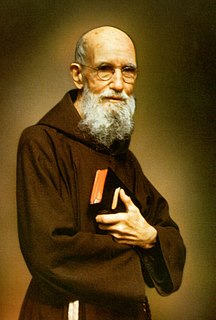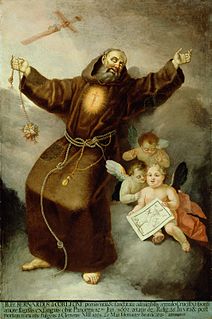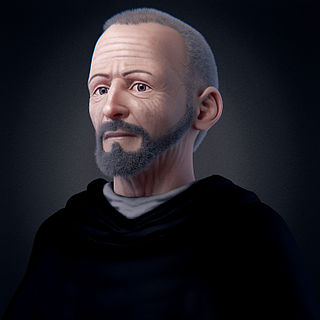
The Order of Friars Minor Capuchin is a religious order of Franciscan friars within the Catholic Church, one of Three "First Orders" that reformed from the Franciscan Friars Minor Observant, the other being the Conventuals. Franciscans reformed as Capuchins in 1525 with the purpose of regaining the original Habit (Tunic) of St.Francis of Assisi and also for returning to a stricter observance of the rule established by Francis of Assisi in 1209.

John of Ávila was a Spanish priest, preacher, scholastic author, and religious mystic, who has been declared a saint and Doctor of the Church by the Catholic Church. He is called the "Apostle of Andalusia", for his extensive ministry in that region.

Solanus Casey, born Bernard Francis Casey, was a priest of the Catholic Church in the United States and was a professed member of the Order of Friars Minor Capuchin. He was known during his lifetime as a wonderworker, for his great faith and his abilities as a spiritual counselor, but especially for his great attention to the sick, for whom he celebrated special Masses. The friar was much sought-after and came to be revered in Detroit, where he resided. He was also a noted lover of the violin, a trait he shared with his eponym, Saint Francis Solanus.

Leopold Mandić, O.F.M. Cap., was a Croatian Capuchin friar and Catholic priest, who suffered from disabilities that would plague his speech and stature. He developed tremendous spiritual strength in spite of his disabilities and became extremely popular in his ministry as a confessor, often spending 12–15 hours in the confessional.

Seraphin of Montegranaro, was an Italian Capuchin friar who is honored as a saint by the Catholic Church.

Bernardo da Corleone, born Filippo Latini, was a Roman Catholic professed religious from the Order of Friars Minor Capuchin.

Diego José de Cádiz (1743–1801) was a Spanish Capuchin friar who was a noted and popular preacher throughout the region of Andalusia during the 18th century. He was beatified by the Catholic Church in 1894.
The Martyrs of the Spanish Civil War are the Catholic Church's term for the people killed by Republicans during the Spanish Civil War for their faith. More than 6,800 clergy and religious were killed in the Red Terror. As of February 2022, 2,069 Spanish martyrs have been beatified; 11 of them being canonized. For some 2,000 additional martyrs, the beatification process is underway.

Blessed Marcelo Rafael José María de los Dolores Hilario Spínola y Maestre was a Cardinal of the Roman Catholic Church who served as the Archbishop of Seville. He established the Handmaids of the Divine Heart.

John Macías, O.P., was a Spanish-born Dominican Friar who evangelized in Peru in 1620. He was canonized in 1975 by Pope Paul VI. His main image is located at the main altar of the Basilica of Our Lady of the Rosary of Lima and is venerated by the local laity in Peru. A church was built in his honor in 1970 in San Luis, Lima, Peru.

José María of Manila is a Spanish Filipino Roman Catholic blessed, and was priest of the Order of Friars Minor Capuchin. He was martyred in the early phase of the Spanish Civil War, and is the third Filipino to have been declared blessed by the Roman Catholic Church.

The 498 Spanish Martyrs were victims of the Spanish Civil War beatified by the Roman Catholic Church in October 2007 by Pope Benedict XVI. It was the greatest numbers of persons ever beatified at once up to that time in the Church's history. They originated from many parts of Spain. Their ages ranged from 16 years to 78 years old. Although almost 500 persons, they are a small part of the Martyrs of the Spanish Civil War.
Jeremiah of Wallachia O.F.M. Cap., was a Romanian-born Capuchin lay brother who spent his entire adult life serving as an infirmarian of the Order in Italy. He was beatified by Pope John Paul II on 30 October 1983, the first of his nation to be so honored. Born Ion Costist or Ioan (John) Costişte, he emigrated to Naples during his adolescence. Also known as Geremia from Wallachia, he became noted for his careful attention to the merciful works and to the care of the poor. His vision of the Blessed Mother resulted in one of the best known images created of him.
The 233 Spanish Martyrs, also referred to as The Martyrs of Valencia or Jose Aparico Sanz and 232 Companions, were a group of martyrs from the Spanish Civil War, who were beatified in March 2001 by Pope John Paul II. This was the largest number of persons beatified at once up to that time. They originated from all parts of Spain but mostly served and died in the diocese of Valencia.

Juan Diego Cuauhtlatoatzin, also known as Juan Diego, was a Chichimec peasant and Marian visionary. He is said to have been granted apparitions of the Virgin Mary on four occasions in December 1531: three at the hill of Tepeyac and a fourth before don Juan de Zumárraga, then bishop of Mexico. The Basilica of Our Lady of Guadalupe, located at the foot of Tepeyac, houses the cloak (tilmahtli) that is traditionally said to be Juan Diego's, and upon which the image of the Virgin is said to have been miraculously impressed as proof of the authenticity of the apparitions.

John of Jesus Hernández y Delgado, was a Spanish Friar Minor and mystic. The cause for his canonization has been submitted to the Holy See.
Saint Juan Grande Román was a Spanish Roman Catholic who was a professed religious of the Hospitallers of Saint John of God. He adopted the name of "John the Sinner" and he died of the plague after he tended to those who suffered from it.

Leopoldo da Gaiche, born Giovanni Croci, was an Italian Roman Catholic priest and a professed member of the Order of Friars Minor who became well known for wearing a crown of thorns. He was a preacher who went from diocese to diocese and served in a position of power in the Franciscan order in the Umbrian region in which he pushed for strong adherence to the Rule of Saint Francis of Assisi. He has been called the "Apostle of Umbria".

The Martyrs of Tlaxcala were three Mexican Roman Catholic teenagers from the state of Tlaxcala: Cristobal (1514/15–1527) and the two companions Antonio (1516/17–1529) and Juan (1516/17–1529). The three Teenagers were converts from the indigenous traditions of their families to the Roman Catholic faith and received their educations from the Order of Friars Minor who baptized them and evangelized in the area. Their activism and evangelical zeal led to their deaths at the hands of those who detested their newfound faith and perceived them as dangers to their values and rituals.














